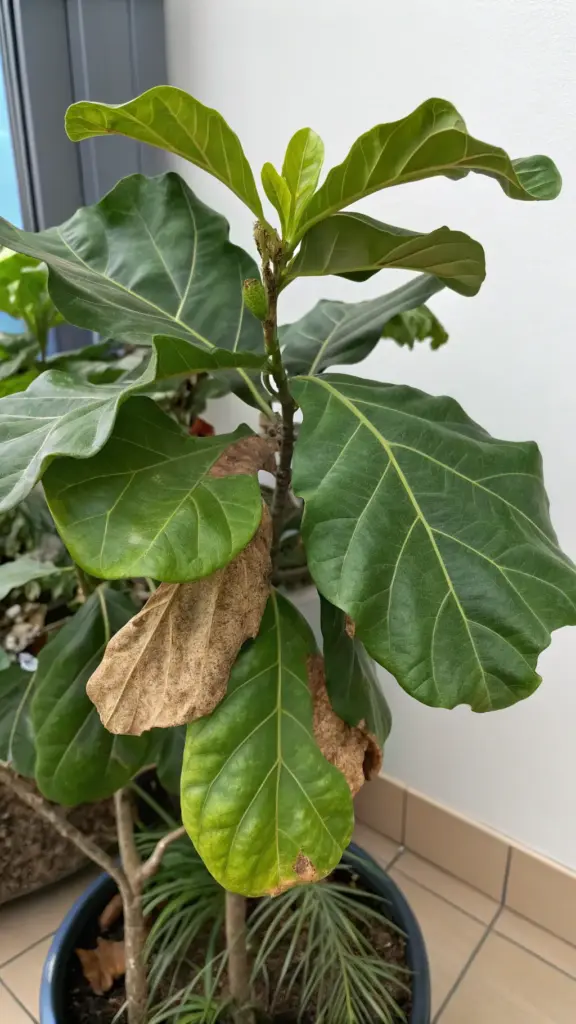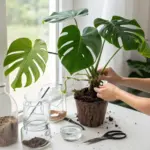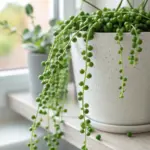3. Your Plant is Suffering from Improper Humidity Levels

I used to think humidity was just something that made my hair frizzy in summer. Then I started noticing my fiddle leaf fig’s leaves getting these weird brown, crispy edges no matter how perfectly I watered it.
Turns out, my bone-dry apartment air was basically sucking the life out of my tropical baby. Most homes sit around 30-40% humidity, but fiddle leaf figs are dreaming of that sweet 50-60% tropical paradise they came from.
The day I bought a cheap humidity meter was the day everything clicked. My living room was registering a desert-like 25% humidity – no wonder my plant looked stressed!
Why Humidity is Make-or-Break for Tropical Plants
Fiddle leaf figs evolved in the humid rainforests of western Africa where the air is thick with moisture. They literally breathe through their leaves, and dry air makes this process way harder.
When humidity levels drop too low, your plant starts losing water faster than it can absorb it through its roots. It’s like trying to drink through a straw while someone’s blowing air in your face.
Proper humidity levels also help prevent pest problems. Spider mites absolutely love dry conditions – they’ll throw a party on your fiddle leaf fig if the air is too dry.
Low humidity also affects how well your plant can photosynthesize. Think of it as your plant trying to work while constantly feeling dehydrated.
Warning Signs Your Plant is Gasping for Moisture
Brown leaf edges are the classic cry for help when humidity is too low. These crispy borders usually start small but can take over entire leaves if you don’t act fast.
I used to think this was a watering issue and kept drowning my poor plant. Turns out, the roots were fine – the leaves just couldn’t handle the dry air.
You might also notice leaf curling where the edges roll inward. Your plant is literally trying to conserve moisture by reducing the surface area exposed to dry air.
Slower growth is another sneaky sign of humidity problems. When your fiddle leaf fig is stressed from dry air, it puts all its energy into survival instead of producing those gorgeous new leaves.
Frequent pest problems can also signal humidity issues. If you’re constantly battling spider mites or scale insects, check your humidity levels first.
DIY Humidity Hacks That Actually Work
The pebble tray method is my go-to budget solution. Fill a shallow tray with pebbles, add water until it’s just below the top of the stones, then place your plant pot on top.
Make sure the pot isn’t sitting directly in water – that’s a one-way ticket to root rot city. As the water evaporates, it creates a nice humid microclimate around your plant.
Grouping plants together creates a natural humidity bubble. I have my fiddle leaf fig surrounded by a few other tropical plants, and they all help each other out.
It’s like they’re having their own little rainforest party in my living room. The collective transpiration from multiple plants can raise humidity by 10-15% in the immediate area.
A wet towel trick works great for quick humidity boosts. Hang a damp towel near your plant (not touching it) and let it air dry naturally.
Budget-Friendly Humidifier Options That Don’t Suck
I’ve tried probably six different cool mist humidifiers over the years. The ultrasonic ones are quieter, but they can leave white dust if you have hard water.
My current favorite is a basic evaporative humidifier that cost about$40. It’s not fancy, but it runs quietly and doesn’t create that weird mineral buildup on my furniture.
Warm mist humidifiers work too, but they use more electricity and can make your space uncomfortably warm. Plus, the hot steam can actually damage leaves if placed too close.
Look for humidifiers with automatic shut-off features and easy-to-clean tanks. Trust me, you don’t want to deal with moldy humidifier water – that’s worse than no humidity at all.
The Plant Grouping Strategy That Changed Everything
I used to scatter my plants all over the apartment like little green decorations. Big mistake – they were all struggling individually instead of helping each other thrive.
Now I have a plant corner where my fiddle leaf fig hangs out with a monstera, a snake plant, and a few pothos. The humidity in that corner stays consistently 15-20% higher than the rest of my apartment.
Strategic plant placement also makes watering easier and creates a more dramatic visual impact. It’s like having an indoor jungle that actually benefits your plants’ health.
Just make sure there’s still good air circulation between plants. Stagnant, humid air is an invitation for fungal problems.
Humidity Mistakes That Can Backfire Spectacularly
Misting leaves seems like a good idea, but it can actually cause more problems than it solves. Water droplets sitting on leaves can lead to bacterial or fungal infections.
I learned this the hard way when my beautiful fiddle leaf fig developed these gross brown spots after a week of daily misting. The humidity boost wasn’t worth the leaf damage.
Over-humidifying is also a real problem. If your humidity consistently stays above 70%, you’re creating perfect conditions for mold and mildew.
Placing humidifiers too close to your plant can cause water damage to leaves. Keep them at least 3-4 feet away and let the moisture disperse naturally.
Don’t rely on bathroom humidity from showers either. That’s way too inconsistent and usually followed by dry air from exhaust fans.
Ready to give your fiddle leaf fig the nutrition boost it’s been craving? Hit “next” to discover the fertilizing mistakes that are probably stunting your plant’s growth – and the simple feeding schedule that can transform weak, pale leaves into glossy green perfection!









GIPHY App Key not set. Please check settings